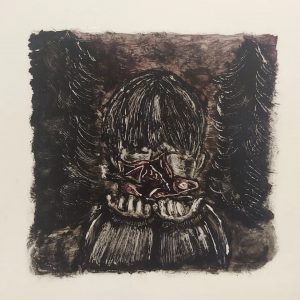21 The Shoe
Joshua Harwood

The Shoe,2021,
Fluid Acrylic on Yupo Paper,
6 inches by 6 inches (2 inch border)
Photograph Credit: Joshua Harwood, 2021
Artist Statement
This work is titled The Shoe, and it was strongly influenced by a project created by native artist Carey Newman called the Witness Blanket. Newman was selected to create the Witness Blanket by the Truth and Reconciliation Commission as a commemorative piece for the Canadian Museum for Human Rights. The blanket itself is a collection of artifacts taken from residential school sights all over Canada. My idea for The Shoe comes from a story Newman told of a child’s shoe that was found at one of the residential school sites. Newman and his associates that discovered the shoe felt a very strong spiritual connection to it. This painting, much like its influencers, is a response to the idea of decolonization and reconciliation. In my painting, I have portrayed the spirit of a residential school child offering up the shoe to the viewer. The spirit itself acts as a messenger that represents all residential school victims and survivors. By offering up the shoe, the spirit is also offering up the memories and experiences of all residential school children for future generations.
As an artist, I have developed a style of painting that uses only black paint (I use knives and other tools to scratch away information to reveal lighter areas in the painting). I paint figures, sceneries, and backgrounds in a way that blurs the lines between realism and abstraction. My figures have no eyes and are represented in a very gestural-like approach. By excluding an important facial detail like eyes, I feel it allows the viewer to focus on the deeper meaning in the painting.
The Shoe serves as a tribute to all residential school survivors and victims. The memory of those who suffered the unspeakable atrocities under the residential school program should never be forgotten. This work of art aims to bring their collective memory to the forefront of our current consciousness, as a society that is in the midst of dealing with the unearthing of a horrible past. This work also aims to serve as a constant reminder that the efforts to decolonize and reconcile with our indigenous brothers and sisters is an important venture to be sure.

